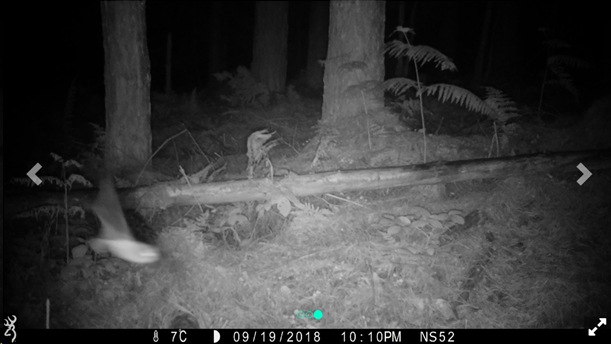Data Diaries #2 - Camera traps in coniferous forest
Data is at the core of what we do as a Local Environmental Records Centre. This series shines a light on the breadth and variety of the records we receive and how we deal with them.
Camera traps are a well-known method by which we can observe wildlife. Their unobtrusive nature and ability to be set up and left in one location allows for us to glimpse wildlife that it might otherwise fly under the radar and give us excellent insight into the range of species occupying a certain location.
In 2021 we received a huge number of camera trap records as part of the Yorkshire Pine Marten Support Programme which began in 2018. This Heritage Lottery Fund Project was managed by conservation organisation NatureSpy with the aim of trying to identify locations of elusive Pine Marten across the Yorkshire Forest in North Yorkshire.
The project came to an end in 2021 and allowed for a much-improved understanding of the state of the Pine Marten in the region using camera traps, DNA surveys, and responding to incidental sightings from the public. The engagement arm of the project also helped highlight the plight of this mammal and their poor conservation status. Unfortunately, no Pine Marten were recorded on camera trap throughout the project, however, on its completion their project officer Ed Snell contacted us to provide over 14,000 records of incidental captures from the project.
An example of one of the captures from the project on MammalWeb - in this case, a Roe Deer.
The records were collected from 50 camera traps deployed in over 60 surveys over the project’s three-year timeline, which was facilitated by a huge volunteer effort. The cameras were deployed mainly in the coniferous forests of the North York Moors.
The incidental records comprise of over 55 species of mainly mammals and birds. This includes some species for which we have few records in our database, such as Nightjar, or species like Mink, where understanding their distribution is important as an invasive, non-native species. Roe Deer was the most common species recorded, but the cameras were also able to provide imaging to positively identify some surprisingly small mammals, such as Bank Vole and Pygmy Shrew. The records also included protected species such as Badger and some iconic woodland species such as Great Spotted Woodpecker. This dataset is likely supplement our existing data in a valuable way as several locations included represent gaps in our database, probably due the relative inaccessibility of some of the forested areas used in the survey - it has certainly helped ‘add dots to maps’ in several under-recorded areas.
Incidental records from targeted recording and conservation projects are a valuable source of records (alongside records of the target species, if they occur) for a number of reasons. They often have a certain habitat, site, or taxon group focus, which we are particularly interested in receiving, and often also benefit from expert validation by project officers or taxon experts before they arrive with us. In this case, all 14,000 records were verified by Ed, the project officer, and MammalWeb, which allows citizen scientists to help identify species detected on camera traps for various projects across the UK.
A Bat fly-by caught on camera!
To process the raw data sent to us via spreadsheet, we ensured that the survey methods and project-specific information was captured alongside the basic record information. This involved maintained the unique references provided with each record which linked each one to a specific site and an individual camera, and ensuring the ‘sample type’ was listed and visible as Camera Trap/Trail Cam. With verification already complete, we finished the preparation by mapping each record to exclude any which lay just beyond the NEYEDC LERC area and used this mapping to provide additional information to supplement a Site/Location name where needed.
Though NEYEDC are no stranger to a camera trap (not least courtesy of the many occupying our office cupboard…) datasets of this size that use the method are unusual and interesting to recieve - making it well worthy of documenting in our Data Diaries series.
You can read more about NatureSpy here: https://naturespy.org/what-we-do/. You can also read Ed’s blog for our 100 Species series, where he talks more about their work with Pine Marten: #5 Pine Marten by Ed Snell — neyedc. We’re very grateful to have received records from their project, which will be utilised in our reporting database for consideration in local decision making whilst adding to our existing knowledge of the fauna of coniferous forests in our region.
A snowy Jay from 2019, as part of the project on MammalWeb.



